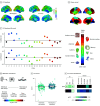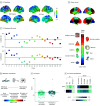Patterns of Brain Maturation in Autism and Their Molecular Associations
- PMID: 39412777
- PMCID: PMC11581727
- DOI: 10.1001/jamapsychiatry.2024.3194
Patterns of Brain Maturation in Autism and Their Molecular Associations
Abstract
Importance: In the neurotypical brain, regions develop in coordinated patterns, providing a fundamental scaffold for brain function and behavior. Whether altered patterns contribute to clinical profiles in neurodevelopmental conditions, including autism, remains unclear.
Objectives: To examine if, in autism, brain regions develop differently in relation to each other and how these differences are associated with molecular/genomic mechanisms and symptomatology.
Design, setting, and participants: This study was an analysis of one the largest deep-phenotyped, case-control, longitudinal (2 assessments separated by approximately 12-24 months) structural magnetic resonance imaging and cognitive-behavioral autism datasets (EU-AIMS Longitudinal European Autism Project [LEAP]; study dates, February 2014-November 2017) and an out-of-sample validation in the Brain Development Imaging Study (BrainMapASD) independent cohort. Analyses were performed during the 2022 to 2023 period. This multicenter study included autistic and neurotypical children, adolescents, and adults. Autistic participants were included if they had an existing autism diagnosis (DSM-IV/International Statistical Classification of Diseases and Related Health Problems, Tenth Revision or DSM-5 criteria). Autistic participants with co-occurring psychiatric conditions (except psychosis/bipolar disorder) and those taking regular medications were included.
Exposures: Neuroanatomy of neurotypical and autistic participants.
Main outcomes and measures: Intraindividual changes in surface area and cortical thickness over time, analyzed via surface-based morphometrics.
Results: A total of 386 individuals in the LEAP cohort (6-31 years at first visit; 214 autistic individuals, mean [SD] age, 17.3 [5.4] years; 154 male [72.0%] and 172 neurotypical individuals, mean [SD] age, 16.35 [5.7] years; 108 male [62.8%]) and 146 individuals in the BrainMapASD cohort (11-18 years at first visit; 49 autistic individuals, mean [SD] age, 14.31 [2.4] years; 42 male [85.7%] and 97 neurotypical individuals, mean [SD] age, 14.10 [2.5] years; 58 male [59.8%]). Maturational between-group differences in cortical thickness and surface area were established that were mostly driven by sensorimotor regions (eg, across features, absolute loadings for early visual cortex ranged from 0.07 to 0.11, whereas absolute loadings for dorsolateral prefrontal cortex ranged from 0.005 to 0.06). Neurodevelopmental differences were transcriptomically enriched for genes expressed in several cell types and during various neurodevelopmental stages, and autism candidate genes (eg, downregulated genes in autism, including those regulating synaptic transmission; enrichment odds ratio =3.7; P =2.6 × -10). A more neurotypical, less autismlike maturational profile was associated with fewer social difficulties and more typical sensory processing (false discovery rate P <.05; Pearson r ≥0.17). Results were replicated in the independently collected BrainMapASD cohort.
Conclusions and relevance: Results of this case-control study suggest that the coordinated development of brain regions was altered in autism, involved a complex interplay of temporally sensitive molecular mechanisms, and may be associated with both lower-order (eg, sensory) and higher-order (eg, social) clinical features of autism. Thus, examining maturational patterns may provide an analytic framework to study the neurobiological origins of clinical profiles in neurodevelopmental/mental health conditions.
Conflict of interest statement
Figures



Comment on
-
Development of Sensory Regions vs the Rest of the Cortex in Autism.JAMA Psychiatry. 2024 Dec 1;81(12):1175-1176. doi: 10.1001/jamapsychiatry.2024.3049. JAMA Psychiatry. 2024. PMID: 39412795 No abstract available.
References
-
- American Psychiatric Association . Diagnostic and Statistical Manual of Mental Disorders. 5th ed. American Psychiatric Association; 2013.
Publication types
MeSH terms
LinkOut - more resources
Full Text Sources
Medical

